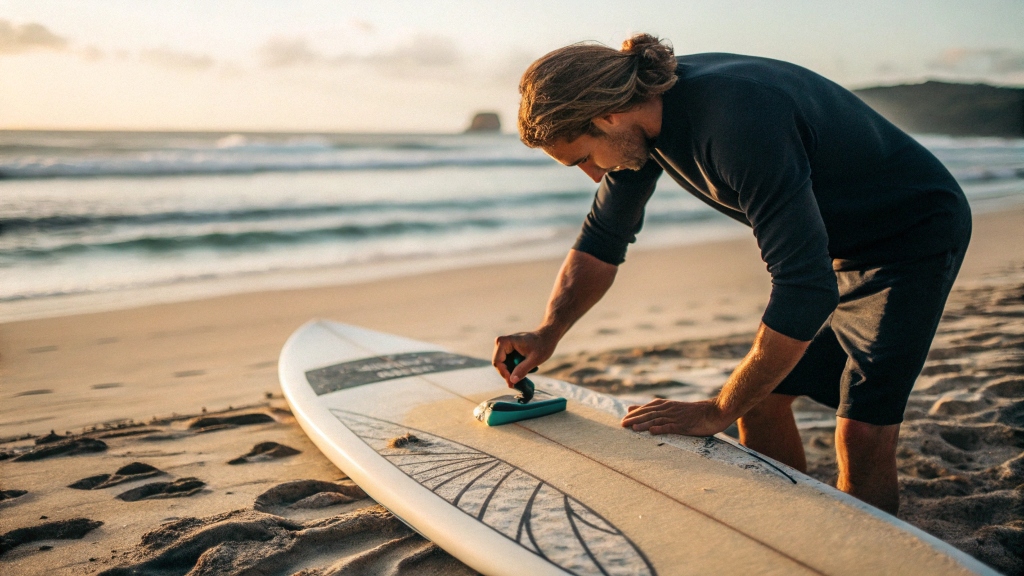Ditch the Wax: Real Solutions to Grip Problems in Surfing Without the Sticky Mess

There’s nothing worse than missing a perfect wave because your feet slipped off the board. For decades, surf wax has been the go-to fix for grip problems. But as boards evolve, so do preferences. More surfers are now looking for alternatives that don’t melt, mess, or demand constant reapplication.
Whether it’s the hassle of re-waxing or the environmental harm of traditional waxes, a growing community wants change. And they’re not wrong. The surf world is shifting toward smarter, more sustainable grip options.
I remember my own turning point. On a surf trip to Bali, the heat melted my wax within minutes. I spent half the session sliding, and the other half reapplying wax on the beach. It made me rethink everything. Since then, I’ve tested a range of wax alternatives—and it changed my surfing forever.
If you’re in the same boat, you’re not alone. A great place to learn more about progressive surf solutions is to explore The Surfing Village. It’s a hub for forward-thinking surfers who want better gear, better waves, and better grip.
Why Wax Alternatives Are Taking Over

For many surfers, the idea of ditching wax feels like giving up an old friend. However, surf wax has its flaws. It melts in heat, hardens in cold, and pollutes the ocean with microplastics and petroleum-based residue.
Environmental Impact
A 2020 study by Environmental Science & Technology found that traditional wax contributes to microplastic pollution. Every surf session adds tiny wax particles to the sea, many of which never break down.
In fact, wax can contain up to 60% paraffin, a petroleum byproduct. This alone has led many eco-conscious surfers to look for cleaner options.
Performance Concerns
Even the best wax job can fail. It wears off unevenly and becomes patchy, especially during long sessions. And when the sun’s out, it can melt completely. That’s where alternatives offer an edge—they promise consistent grip, even when conditions change.
Market Growth
The market for wax alternatives is growing. According to Global Surf Market Insights 2023, traction pads and eco-grip coatings are gaining popularity, especially among newer surfers who value ease of use.
It’s also about gear synergy. As soft-top and epoxy boards become more popular, so do modern grip solutions that match their material and style.
Types of Wax Alternatives for Surfboards
1. Traction Pads
Traction pads are the most common wax replacement. They’re typically made from EVA foam, which provides long-lasting grip. You stick them directly on the board where your back foot lands.
- Pros: Long-lasting, easy to clean, water-resistant
- Cons: Limited foot placement flexibility, difficult to reposition once applied
Many brands offer tail pads with arch support and kicktails for performance. Some even come with eco-foam made from algae or recycled materials.
2. Full Deck Grip Pads
These go a step further than traction pads by covering the entire board deck.
- Pros: Excellent grip across the board, great for beginners and soft-top boards
- Cons: Can add weight, limits foot movement for advanced tricks
These are ideal for surf schools or beginners who don’t want to deal with wax at all.
3. Clear Grip Sprays and Films
Clear grip sprays and films offer an invisible grip layer. They’re gaining traction (pun intended) for their minimalist look.
- Pros: Keeps the natural look of the board, easy to apply, non-toxic options available
- Cons: Shorter lifespan, less aggressive grip compared to foam pads
One of the popular solutions in this category is the RSPro HexaTraction, which uses lightweight, transparent hexagon patterns that look sleek and perform well.
Real-World Experience with Grip Sprays and “Hyper Flex” Pads
On a recent trip to Costa Rica, I decided to test the hype behind modern grip solutions. I installed a full-deck grip pad made from a new foam material called hyper flex, and I was skeptical at first.
The hyper flex material, designed for flexibility and traction, felt weirdly soft at first. But once I hit the water, I noticed the difference immediately. My feet felt glued to the board—even during duck dives and hard carves.
Unlike wax, it didn’t wear off during long sessions. And after a week of surfing every day, it was still going strong.
It wasn’t just easier; it was better.
Pros and Cons of Switching to Wax Alternatives
No solution is perfect. But many alternatives offer better consistency and sustainability. Here’s a quick breakdown:
Advantages:
- Low Maintenance: No more reapplying before every session
- Eco-Friendly: Many options are biodegradable or made from recycled materials
- Durability: Some grip solutions last for years, not days
Drawbacks:
- Cost: Higher upfront cost compared to wax
- Permanent Application: Some pads are hard to remove or reposition
- Style Preference: Some surfers still prefer the feel and flex of traditional wax
However, the benefits usually outweigh the downsides, especially for frequent surfers or those who travel to hot climates.
According to a report by Surf Science Journal (2021), 67% of surveyed surfers who switched to grip pads said they performed better in high-temperature conditions. Another study from EcoBoard Review (2022) found that biodegradable grip films reduce water waste by up to 20% compared to wax production and cleanup.
Surfers who used eco-grip solutions also reported fewer board cleanings, saving time and extending board life. These studies show the shift is not just hype—it’s real progress.
Tips for Making the Switch
Ready to ditch the wax? Here’s how to make a smooth transition:
- Test Before You Commit
Try a tail pad first. It gives grip without a full switch. - Consider Your Surf Style
Shortboarders may prefer precise grip zones, while longboarders might like full-deck coverage. - Mind the Application
Clean your board thoroughly before applying any pad or spray. Use alcohol wipes or board cleaner. - Check Compatibility
Not all grip pads stick well to soft tops or textured boards. Look for adhesive-backed options labeled for your board type. - Practice Foot Placement
Pads remove flexibility. Practice in dry conditions first to get your footing right.
Read More Also: How Often Do You Take a Cat to the Vet? What Every Cat Parent Should Know
Conclusion
Wax has served the surf world well, but alternatives are clearly making waves. Whether it’s for the environment, performance, or convenience, the switch makes sense.
From personal experience and real research, one thing is clear—modern grip solutions offer an upgrade in consistency, durability, and style.
Got a favorite grip hack or horror story? Drop it in the comments below or share this article with a fellow surfer. Let’s ditch the wax together!
Read More Also: Paddle Board Slipping Cure: How to Stay Balanced and Confident on Your Board
FAQs
What are the best alternatives to surf wax?
The best alternatives include traction pads, full-deck grip pads, and clear grip sprays or films. Each suits different needs.
Are wax alternatives better for the environment?
Yes. Many are made from recycled or biodegradable materials, reducing microplastic and petroleum pollution.
Can I use a grip pad and wax together?
Yes, some surfers still use wax on areas not covered by pads for added grip.
How long do wax alternatives last?
Depending on the product, grip pads can last several years. Grip sprays usually need reapplication every few months.
Do professionals use wax alternatives?
Some pros do, especially in hot climates. Grip pads are common on pro shortboards for added control.








